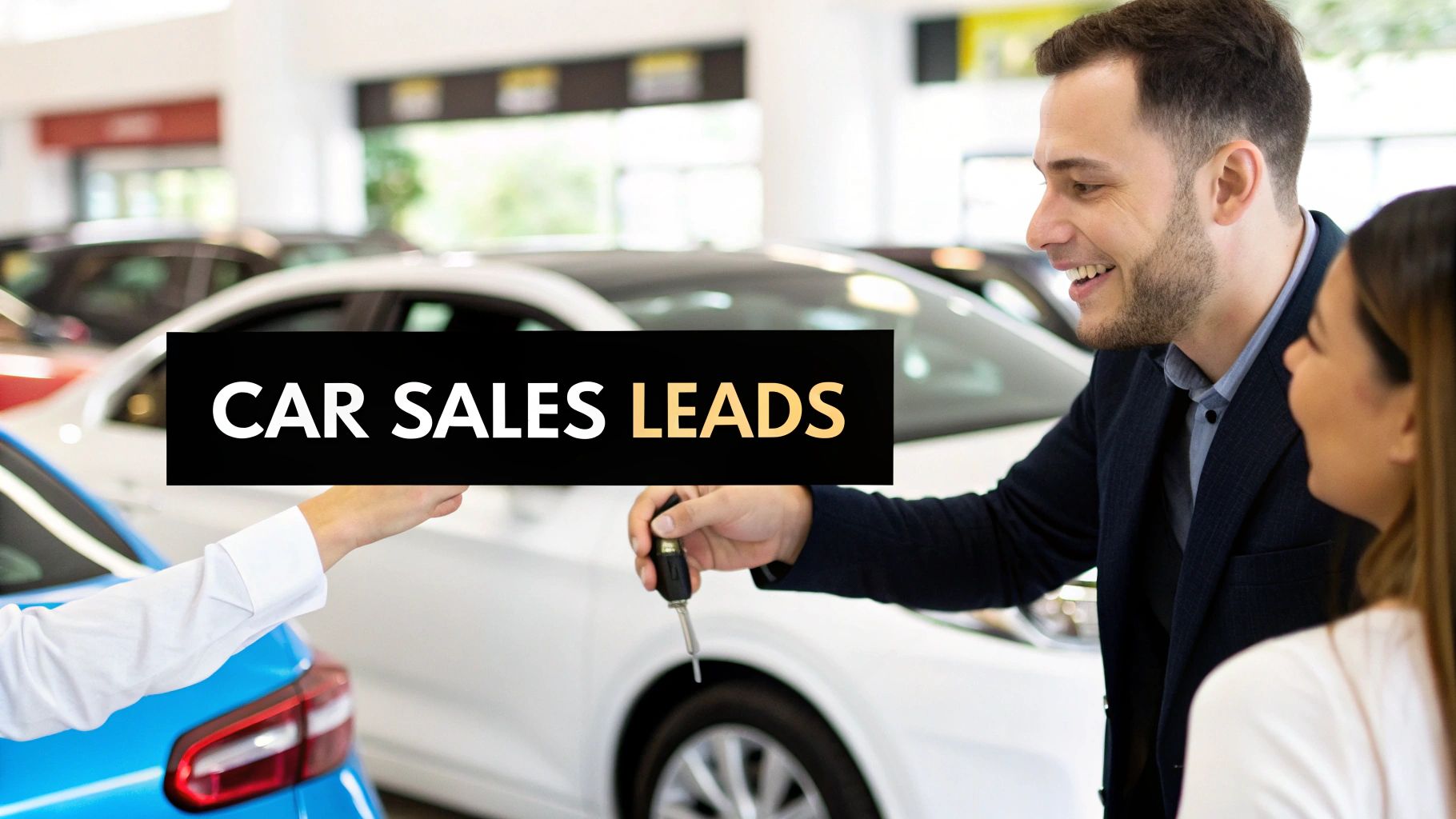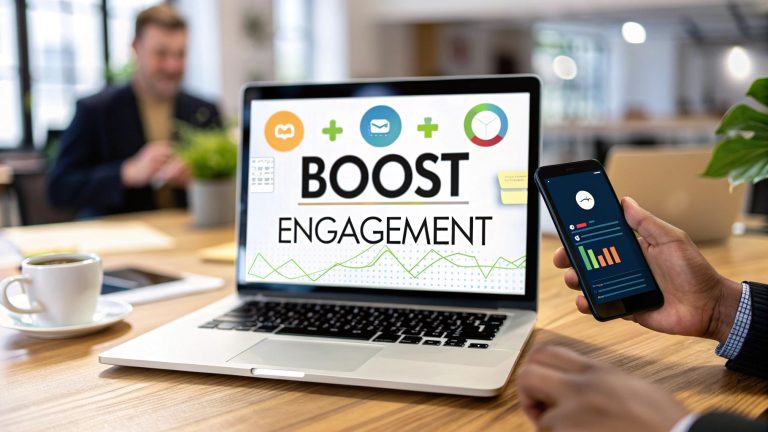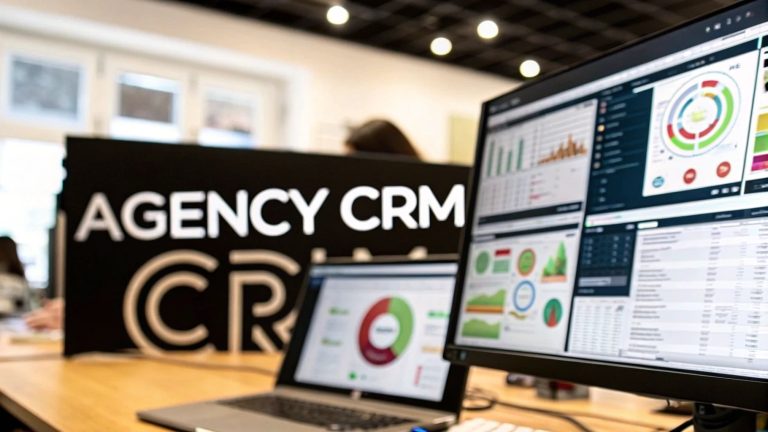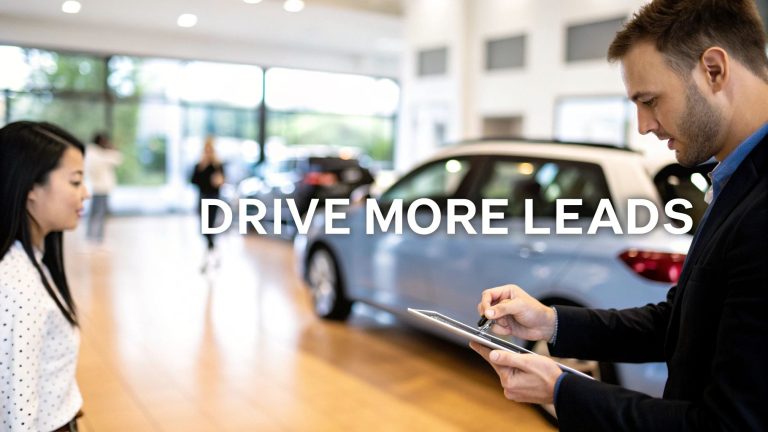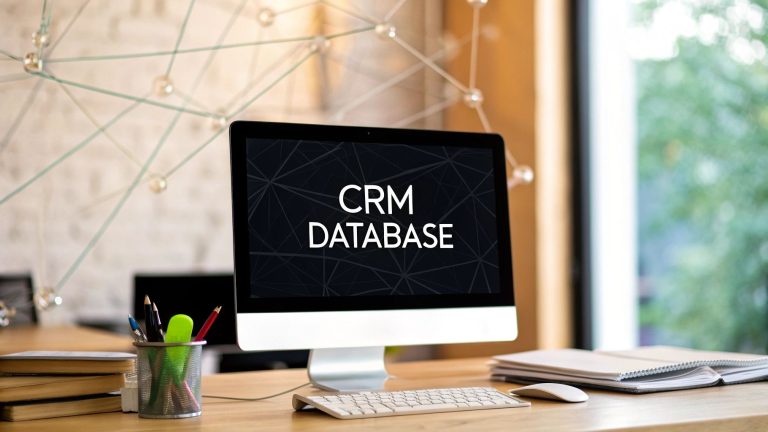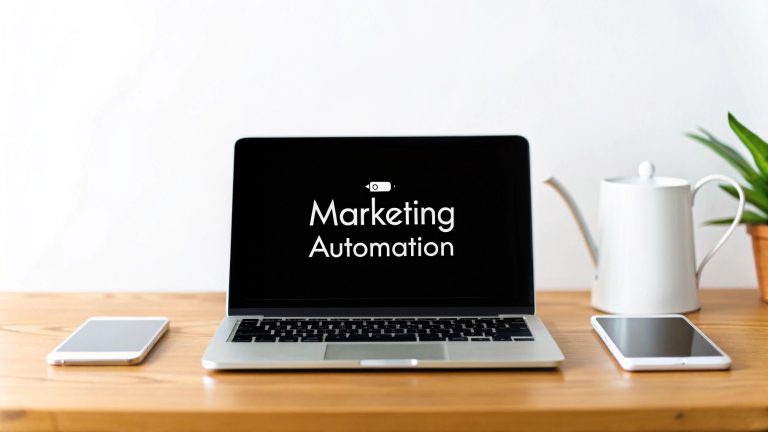A Guide to Lead Generation for Car Sales
Trying to generate more car sales leads? You’re not just looking for names and numbers; you’re building a predictable engine that keeps your showroom busy and your sales pipeline full. It all comes down to attracting potential buyers through channels like Facebook ads, capturing their info, and—most importantly—responding fast.
Get this part right, and you're on your way to consistent traffic and predictable revenue.
Building Your Car Sales Lead Generation Engine
A truly robust lead gen engine isn't just about volume; it's a careful blend of different lead types combined with lightning-fast follow-up. It’s about creating a steady flow of opportunities.
Most dealerships I work with aim for 100 to 150 leads every single month to hit their sales targets, which just shows how critical a consistent stream of new prospects is. You can find more insights on what's working now in our deep-dive on automotive lead generation.
To hit those numbers, you need a mix of "hot" leads (ready to buy now) and "warm" leads (still shopping around). A 50/50 split is a great target to maintain a healthy pipeline for both this week's sales and next quarter's.
Here’s a quick look at what that breakdown often looks like in practice.
Dealership Lead Types and Conversion Benchmarks
This table breaks down the two main types of automotive leads, along with realistic monthly goals and what you can expect in terms of conversion rates.
| Lead Type | Monthly Volume Target | Expected Conversion Rate |
|---|---|---|
| Hot Leads | 50–75 | 15–25% |
| Warm Leads | 50–75 | 8–15% |
Hot leads are the low-hanging fruit—they often convert within a week. Warm leads, on the other hand, are a longer game, typically converting over a 3 to 6-month period. Having both ensures you’re not just focused on the immediate sale but are also nurturing future buyers.
Here's a stat that should get your attention: a quick follow-up within the first hour can boost your conversions sevenfold. Speed is non-negotiable.
This whole process, from that initial click to a final sale, is a journey.
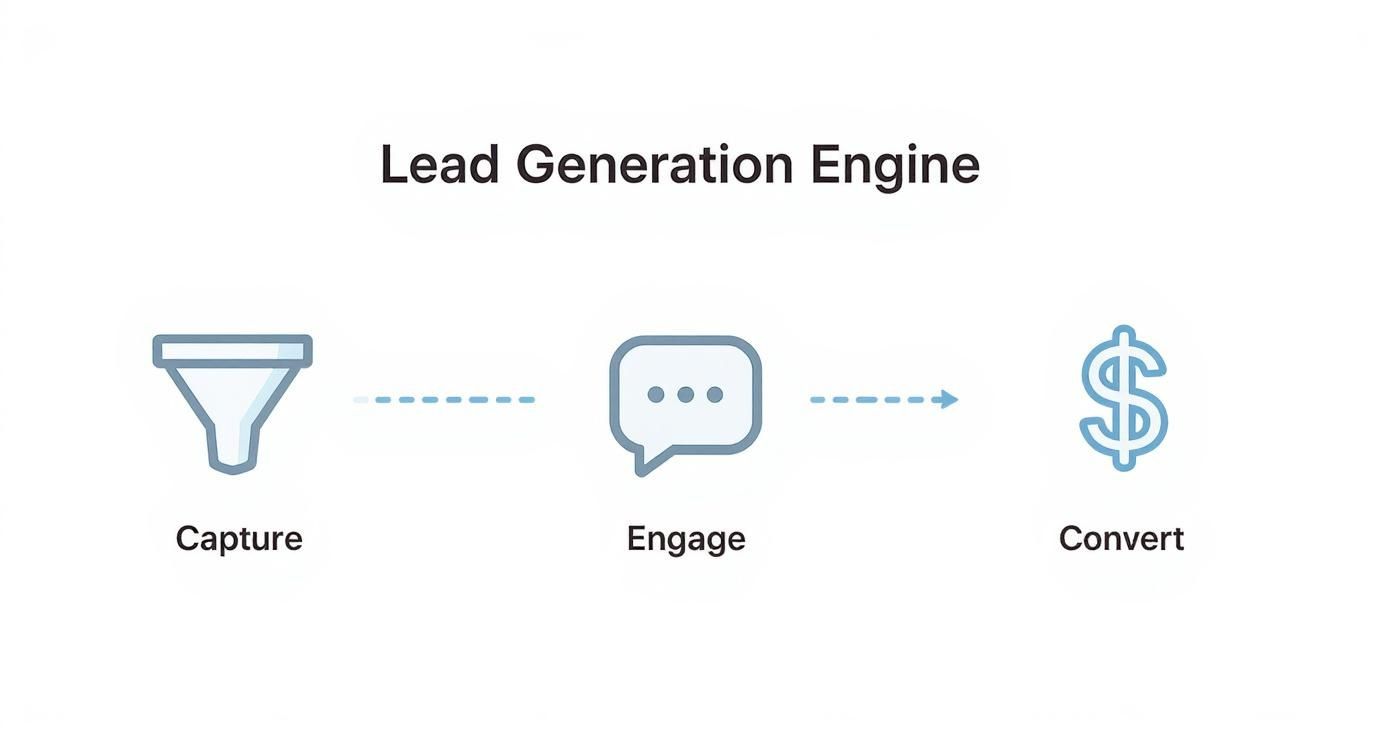
As you can see, solid engagement is what bridges the gap between someone showing interest and actually signing the papers.
Streamlining Your Response Process
I can't stress this enough: speed matters more than anything else in car sales. When a lead comes in, the clock is ticking. Responding within 60 minutes increases your odds of closing the deal by a whopping 7x.
This is where a little automation goes a long way. You don't need anything complicated.
- Use a simple SMS script the moment a lead comes in. Something like: 'Hi [Name], thanks for your interest in the [Car Model]! Are you available this week for a quick test drive?'
- Automate a follow-up email with a personalized subject line that references the exact model they were looking at.
Combining these automated digital touches with a real human follow-up call is the secret sauce. It keeps your dealership top-of-mind without feeling robotic.
Tracking the Right Performance KPIs
To know if your engine is running smoothly, you have to watch the dashboard. Focus on the metrics that actually move the needle: lead response time, conversion percentage, and your cost per lead (CPL).
Here are some solid benchmarks to aim for:
- Response Time: Keep it under 1 hour. Under 5 minutes is even better.
- Conversion Rate: Aim for around 20% for your hot leads.
- Cost Per Lead (CPL): Try to keep this under $50.
Check these numbers regularly. If something is off, it’s a sign you need to tweak your ad targeting, your offer, or your follow-up scripts. Building a dedicated lead generation engine is what separates the dealerships that thrive from those that just survive. It's all about creating a reliable, data-driven process that keeps your pipeline full.
Finding Your Ideal Car Buyer
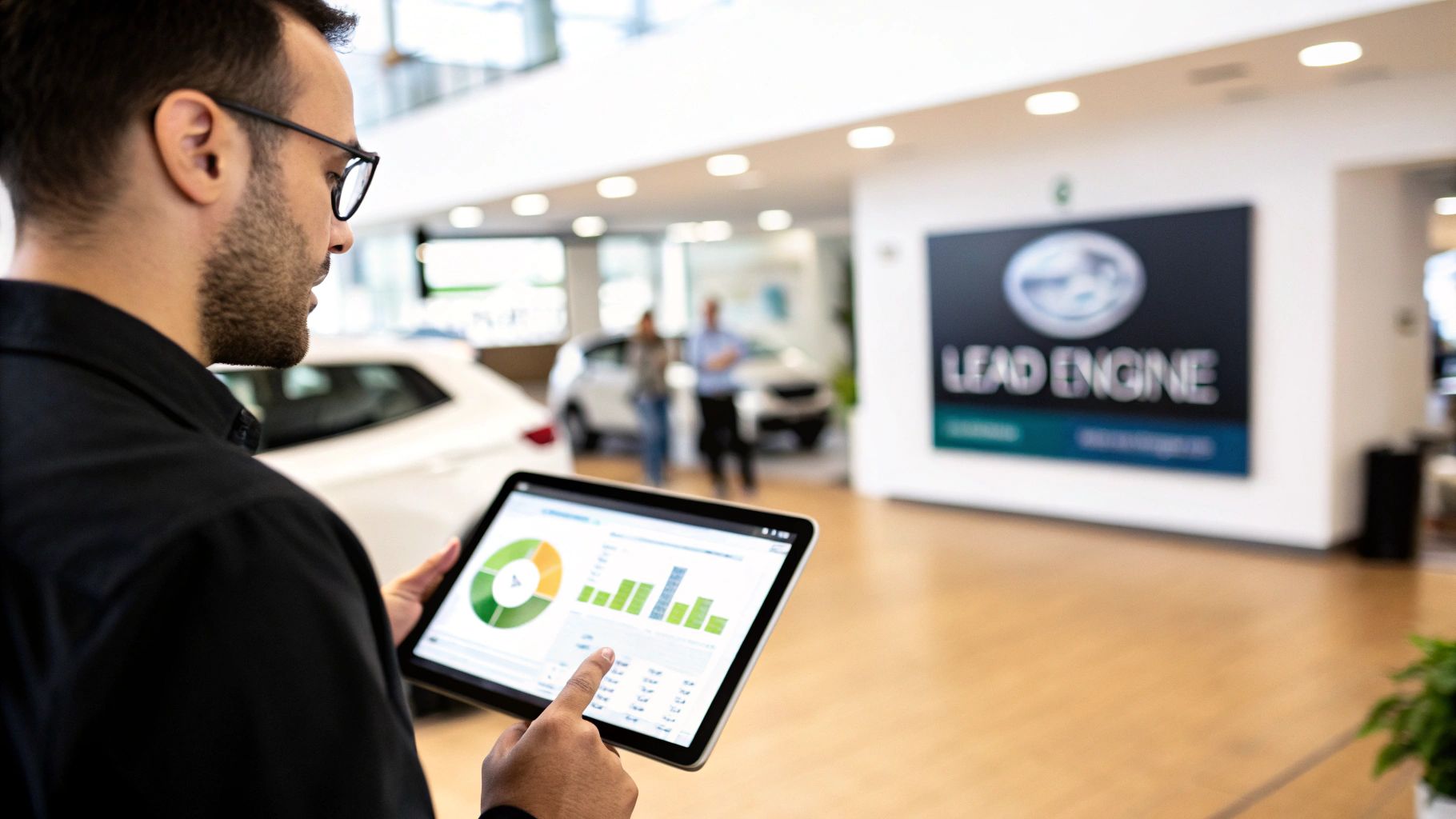
Generating quality leads for car sales isn’t just about firing off ads. It begins with truly knowing who you’re talking to. Blast everyone with a generic message, and you’ll watch your budget disappear with little to show for it.
Instead, think deeper than age and ZIP codes. Picture the actual human needs that drive a purchase. A single professional hunting for a fuel-efficient commuter has different priorities than a family in search of a spacious three-row model. Your copy, visuals, and incentives need to tap into those motivations.
Defining Your Buyer Personas
Buyer personas are detailed sketches of your ideal customers, built on real data and conversations. They give your marketing direction and power your campaigns to hit the right notes. To start, pull reliable data from your CRM and sales records.
Look for trends in:
- Demographics: Age brackets, income tiers, and hometowns that keep recurring.
- Purchase Triggers: Life changes—like a new job, a growing brood, or an expiring lease—that prompted someone to buy.
- Vehicle Preferences: What matters most? Peak fuel economy, family-safe features, extra cargo room, or a thrilling drive?
With these insights, assumptions transform into clear action points. You’ll know exactly which messages resonate and which ones fall flat. For example, marketing your latest sports coupe by talking about the LATCH system for car seats? That’s a mismatch.
The best campaigns come from genuine empathy. When you get inside your buyers’ heads, their pain points become the very foundation of your next winning offer.
Standing out matters. This market is busy—new-vehicle sales are predicted to climb by 7.5% in the first half of this year alone. You can read more about global automotive sales forecasts at J.D. Power.
Crafting Offers That Create Urgency
Once your target profile is clear, it’s time to align your offer with their priorities. Standard discounts vanish into the background noise. Instead, make each deal feel like it’s made just for them.
Think about these real scenarios:
- Budget-Conscious Commuter: Bundle a “First Year of Maintenance on Us” or a rock-bottom APR special to promise predictable costs.
- Tech-Savvy Millennial: Host an exclusive hands-on demo event showcasing the newest infotainment and driver-assist features.
- Busy Family: Offer “White Glove Test Drives” that bring the SUV right to their driveway—saving parents the hassle.
These tailored incentives show you understand their day-to-day challenges. By delivering value before they ever arrive at the dealership, you’ll build trust and warm up leads in a way generic promos never could.
Running High-Converting Facebook Lead Ads
You've figured out who your ideal customer is. Now, you need to meet them where they're already spending their time: Facebook.
Facebook's Lead Ads are a game-changer for car sales because they make the entire process incredibly smooth for the user. A potential buyer can express interest and send you their info without ever leaving the Facebook app. This simple detail massively cuts down on friction and skyrockets your lead submission rates.
The real magic happens when you pair those finely-tuned audience segments with ad creative and copy that speaks directly to their pain points. Don't just run a generic ad for a new SUV. Instead, target families in your local area with a quick video that highlights its top safety ratings and shows off the flexible cargo space. When your message hits home like that, you get results.
Building Your Ad in Ads Manager
Hopping into Facebook Ads Manager and just uploading a picture won't cut it. You need to think through every single piece of the puzzle—from the headline all the way to the questions on your lead form—to make sure you're attracting people who are actually ready to buy.
Here’s a practical setup I’ve seen work wonders for dealerships:
- Campaign Objective: Always choose "Leads." This tells Facebook's algorithm exactly what you want—more form submissions. It's the most direct path to your goal.
- Audience: Don't guess. Use a Lookalike Audience built from your existing customer list. Or, get granular and target users based on interests like specific car brands, auto financing, or even people who follow competing dealerships.
- Ad Creative: Video is king here. A high-quality walkaround video or a slick carousel ad showing off crisp interior and exterior shots will almost always outperform a static image.
You'll customize your questions in the lead form creation interface, which is where the real strategy comes in.
This is where you have to find the right balance. You need enough information to qualify the lead, but you can't ask so many questions that people give up halfway through.
Your goal is to grab the essentials: name, email, and phone number. Then, add just one simple qualifying question like, "When are you looking to purchase a vehicle?" This keeps the form short, sweet, and easy to complete, which is key to getting a high volume of leads.
For a much deeper dive, our complete guide on how to create effective Facebook Lead Ads walks you through every single step in detail.
Crafting Compelling Ad Copy and Headlines
Think of your ad copy as your digital handshake. It needs to be clear, persuasive, and focused entirely on what the customer gets out of the deal—not just a list of features. Ditch the dealership jargon and speak their language.
The best headlines I've seen almost always ask a direct question or state a powerful benefit. For instance, "Tired of Your High Car Payment?" is going to grab way more attention than "New Financing Options Available."
And please, always include a strong call to action (CTA). "Learn More" is lazy and uninspiring. Use action-driven phrases that set clear expectations, like "Get My Trade-In Value" or "Check Local Inventory." These CTAs get clicks from people who are genuinely interested.
Don't forget to A/B test your headlines and ad creative. The data doesn't lie. Testing is the absolute best way to figure out what resonates with your audience so you can optimize your ad spend and bring in much higher-quality leads.
Choosing Between Landing Pages and Lead Forms

You’ve nailed the perfect Facebook ad. The copy is tight, the creative is slick. Now comes the million-dollar question: where do you send people who click?
This decision—sending prospects to an on-platform lead form versus a dedicated landing page—can make or break your campaign. It’s a classic battle of quantity versus quality, and there’s no single right answer. The best move depends entirely on what you're trying to achieve.
The Case for Facebook Lead Forms
A Facebook lead form is all about speed and volume. It keeps users right inside the app, which is a massive win for user experience. Better yet, it pre-fills their name and email straight from their profile. Frictionless.
This is your go-to when your main goal is to build a big list, fast. Think major sales events or promotions where you need to cast a wide net. It minimizes the effort required from the user, so you’ll see a higher number of leads roll in.
But there’s a catch. Because it’s so easy to submit, the intent behind these leads can be a mixed bag. You'll definitely get more leads, but many will be earlier in their buying journey—just kicking tires, so to speak.
When a Dedicated Landing Page Makes More Sense
On the flip side, a dedicated landing page is your secret weapon for capturing high-intent buyers.
Think about it: sending someone off of Facebook forces them to take an extra step. That small bit of friction is actually a good thing—it weeds out the casual browsers from the serious shoppers. This is where you get to control the narrative, tell a deeper story, and really sell the dream.
A well-built landing page gives you the real estate to:
- Showcase slick, high-quality video walkarounds of specific models.
- Feature an interactive car configurator so they can build their perfect ride.
- Provide detailed vehicle specs and a gallery of high-res images.
- Build trust with customer testimonials and dealership awards.
This extra content warms up the lead and builds serious credibility. Anyone who takes the time to visit your landing page and then fills out a form has shown they are genuinely interested. Your sales team will thank you for these kinds of leads.
The Bottom Line: Lead forms are fantastic for generating a high volume of top-of-funnel leads at a lower cost. Landing pages are designed to attract a smaller number of higher-quality, bottom-of-funnel leads who are much closer to making a decision.
Landing Page vs Lead Form: A Practical Comparison
So, when do you use which? This table breaks down the core differences to help you decide where to send your traffic for maximum impact in your automotive campaigns.
| Factor | Landing Page | Lead Form |
|---|---|---|
| Primary Goal | Quality & High Intent | Volume & Speed |
| User Experience | More steps, requires leaving app | Seamless, stays within Facebook |
| Lead Quality | Higher, more qualified | Varies, often lower intent |
| Content Depth | Unlimited (videos, specs, testimonials) | Limited to the form fields |
| Setup Effort | More complex (design, hosting) | Simple, built into Facebook Ads |
| Cost Per Lead | Typically higher | Typically lower |
| Best For | "Get Pre-Approved," Test Drive Booking | "Download a Brochure," Sales Event RSVP |
Ultimately, choosing the right tool comes down to matching it with your campaign’s objective.
Making the Right Call for Your Dealership
Let’s get practical. If you’re running a "Get Pre-Approved" offer for serious buyers, a secure landing page with a financing application is the only way to go. But for a "Download Our SUV Comparison Guide" campaign? A simple Facebook lead form is perfect.
Many of the most successful dealerships I've worked with use a hybrid strategy. They run high-volume lead form campaigns to keep the top of the funnel full, while running more targeted landing page campaigns to capture those ready-to-buy prospects.
My advice? Test both. See what works for your market and your offers. Let the data tell you which approach drives the best lead generation for car sales at your dealership.
Mastering the Art of Immediate Follow-Up
The second a prospect hits submit on your lead form, a countdown timer starts. In the dog-eat-dog world of car sales, the first dealership to respond almost always wins. If a lead feels like they're shouting into the void, they'll just click on the next dealership in their Google search. Simple as that.
This isn’t just a hunch; the numbers don't lie. Industry data shows that leads contacted within the first hour are a staggering seven times more likely to convert. And yet, the average dealer response time is a sluggish 9.2 hours. That gap isn't a problem—it's a massive opportunity for anyone willing to be fast. You can dive deeper into the latest automotive marketing trends and response times if you want to see just how big that opportunity is.
The golden window? The first five minutes. Your only goal in that window is to make immediate, personal contact, confirm you got their request, and tell them what's next.
Your Five-Minute Follow-Up Playbook
When a new lead lands in your CRM or spreadsheet, you need to hit them from two angles: a phone call and a text message. It's the one-two punch that cuts through the noise.
If they don't pick up the phone (and they probably won't), don't just hang up. Leave this exact voicemail.
Voicemail Script:
"Hi [Prospect Name], this is [Your Name] from [Dealership Name]. You just requested some information on the [Car Model], and I wanted to let you know I’ve received it. I’m sending you a quick text with my direct line right now. Talk soon!"
It’s perfect. It's not pushy, it confirms their request was seen by a real human, and it primes them for the text you're about to send. You instantly come across as professional and on top of your game.
The second you hang up, send this text. SMS open rates are over 90%, making it the single most reliable way to get a message in front of someone.
Text Message Script:
"Hey [Prospect Name], it's [Your Name] from [Dealership Name] again. Just left you a voicemail. I'm confirming we have the [Car Model] you're interested in available. Are you free for a quick call later today to discuss it?"
With that simple, two-step process, you've all but guaranteed your dealership is the first one they hear from.
Don't Forget the Follow-Up Email
While the call and text are your immediate blitz, a well-put-together email should land in their inbox within the hour. Think of this as your digital brochure—a professional summary they can come back to later.
Your email absolutely needs three things to work:
- A No-Nonsense Subject Line: Something direct and clear, like "Your [Car Model] Inquiry at [Dealership Name]."
- Confirmation and Value: Quickly re-confirm their interest, but also give them something of value. Attach the vehicle's digital brochure or a direct link to that car on your website.
- A Crystal-Clear Call to Action (CTA): End with a simple, direct question that moves the conversation forward. "When is a good time for a 10-minute call to go over pricing options?" works every time.
This structured follow-up system stops lead generation for car sales from being a passive waiting game. It turns it into an active, strategic engagement that ensures no hot prospect ever goes cold.
Automating Your Lead Management With A CRM
Manual tracking with spreadsheets and sticky notes leads to too many dropped leads. When a hot prospect fills out a form, you need them in your system—immediately. Otherwise, you’re digging through rows of data and watching opportunities slip away from your lead generation for car sales efforts.

A solid CRM integration means every new inquiry lands in the right place without human error. Your sales reps get notified the moment a lead arrives, giving you a real shot at a five-minute window response—which can make or break the deal.
Setting Up Your Automation Workflow
First off, aim to banish manual entry forever. Tools like Zapier or a dedicated service such as LeadSavvy Pro can bridge your Facebook Lead Ads and your CRM or even a Google Sheet.
This isn’t just moving data around. It fires off your whole follow-up engine automatically:
- Instant Sync: Each Facebook lead becomes a CRM contact right away.
- Automatic Assignment: Leads are routed to reps based on availability—no guessing.
- Immediate Notification: Salespeople get an email and SMS alert the second a lead hits the system.
When a lead comes in—day or night—your process springs into action. That quick response gives you an edge others simply can’t match.
For a detailed walkthrough, you can learn more about how to automate your Facebook leads with our guide.
From Simple Syncing To Smart Lead Scoring
Once the basics are in place, it’s time to add intelligence. Follow proven marketing automation best practices by building a lead scoring model right inside your CRM.
Here’s a scenario I’ve used:
- A prospect says they’re “ready to buy this week” → 10 points
- Someone indicates they’re “just browsing” → 2 points
- If they request a test drive in the next 48 hours → 5 points
Reps see the highest-scoring leads first, focusing energy on the hottest opportunities. The result? Faster follow-up, higher close rates, and a leaner, more productive sales process.
Your Top Car Sales Lead Questions, Answered
Let's cut through the noise. Here are some straight-up answers to the most common questions I hear about generating leads for car sales, designed to help you fix what’s broken and get better results, fast.
What’s a Good Cost Per Lead for Car Sales?
Every market is a little different, but a healthy benchmark for your cost per lead (CPL) should land somewhere between $35 to $50.
If you're paying way more than that, it's a huge red flag. Take a hard look at your ad creative, your audience targeting, or the deal you're offering. Getting that CPL down is a core part of a winning lead generation strategy for car sales.
How Can I Get Better Quality Leads?
Tired of chasing tire-kickers? The secret to better lead quality is adding just a little bit of friction to your lead form. Don't just ask for a name and email—that’s too easy for someone who isn't serious.
Toss in one or two qualifying questions. Something simple like:
- "When are you looking to buy your next vehicle?"
- "Do you have a car you're planning to trade in?"
This tiny change does wonders. It weeds out the casual browsers and leaves you with a list of high-intent buyers. This means your sales team can stop wasting time and start focusing on people who are actually ready to talk business.
Want to instantly boost lead quality? Zero in on prospects who signal clear intent to buy. When your team focuses their energy on these leads, your conversion rates will thank you.
Stop losing deals because you were too slow to follow up. LeadSavvy Pro syncs your Facebook leads directly to your Google Sheets or CRM in real-time. Your team can be on the phone in minutes, not hours. Get started for free at LeadSavvy.pro.

